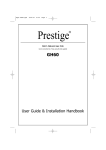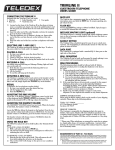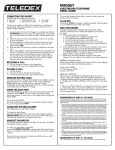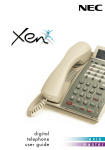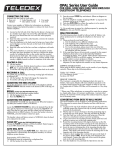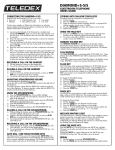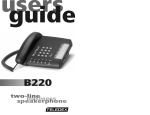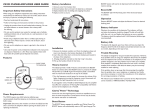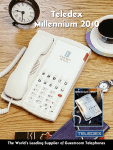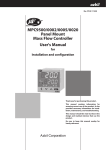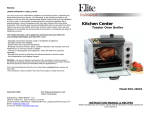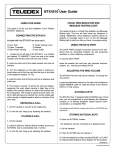Download Opal 2006- 2006S- 2011
Transcript
REQUIREMENTS OF PART 68 - FCC RULES This device has been granted a registration number by the Federal Communications Commission, under Part 68 rules and regulations for direct connection to the telephone lines. In order to comply with these FCC rules, the following instructions must be carefully read and applicable portions followed completely: 1. Direct connection to the telephone lines may be made only through the standard modular cord furnished, to the utility installed jack. No connection may be made to party or coin phone lines. On the bottom of the phone is a label that contains among other information, the FCC Registration Number and the Ringer Equivalence number (REN) for this equipment. If requested this information must be provided to the telephone company. The USOC Jack for this equipment is RJ11C. 2. The telephone company, under certain circumstances, may temporarily discontinue and make changes in facilities and services which may affect the operation of the users' equipment: however, the user shall be given adequate notice in writing to allow the user to maintain uninterrupted service. 3. In certain circumstances, it may be necessary for the telephone company to request information from you concerning the equipment which you have connected to your telephone line. Upon request of the telephone company, provide the FCC registration number and the ringer equivalence number of the equipment which is connected to your line; this information will be found on the device. 4. If any of your telephone equipment is not operating properly, you should immediately remove it from the telephone line. It may cause harm to the telephone network. 5. If the telephone company notes a problem, they may temporarily discontinue service. When practical, they will notify you in advance disconnection. If advance notice is not feasible, the telephone company must; promptly notify you of such temporary discontinuance; afford the opportunity to correct the condition; inform you of your rights to bring a complaint to the FCC under their rules. 6. Repairs to the device may be made only by the manufacturer or an authorized service agency. This applies at any time during and after warranty. If unauthorized repair is performed, registration, connection to the telephone lines and remainder of warranty period all become null and void. 7. This equipment is hearing aid compatible. REQUIREMENTS OF PART 15 users guide - FCC RULES NOTE: This equipment has been tested and found to comply with the limits for a Class B digital device, pursuant to Part 15 of the FCC Rules. These limits are designed to provide reasonable protection against harmful interference in a residential installation. This equipment generates, uses, and can radiate radio frequency energy and, if not installed and used in accordance with the instruction, may cause harmful interference to radio communications. However, there is not a guarantee that interference will not occur in a particular installation. If this equipment does cause harmful interference to radio or television reception, which can be determined by turning the equipment off and on, the user is encouraged to try to correct the interference by one or more of the following measures: -Move the telephone away from the receiver. -Consult the dealer or an experienced radio/TV technician for help. Any changes made by the user not approved by the manufacturer can void the user's authority to operate the telephone. INDUSTRY OF CANADA REQUIREMENTS Notice: The Industry Canada label identifies certified equipment. This certification means that the equipment meets certain telecommunications network protective operational and safety requirements as prescribed in the appropriate Terminal Equipment Technical Requirements documents. The department does not guarantee the equipment will operate to the users satisfaction. Before installing this equipment, users should ensure that it is permissible to be connected to the facilities of the local telecommunications company. The equipment must also be installed using an acceptable method of connection. The customer should be aware that compliance with the above conditions may not prevent degradation of service in some situations. Repairs to certified equipment should be coordinated by a representative designated by the supplier. Any repairs or alterations made by the user to this equipment, or equipment malfunctions, may give the telecommunications company cause to request the user to disconnect the equipment. Users should ensure for their own protection that the electrical ground connections of the power utility, telephone lines, and internal metallic water pipe systems, if present, are connected together. This precaution may be particularly important in rural areas. Caution: Users should not attempt to make such connections themselves, but should contact the appropriate electric inspection authority or electrician, as appropriate. The Ringer Equivalence Number (REN) of this device is Z. Notice: The Ringer Equivalence Number (REN) assigned to each terminal device provides an indication of the maximum number of terminals allowed to be connected to a telephone interface. The termination on an interface may consist of any combination of devices subject only to the requirement that the sum of the Ringer Equivalence Numbers of all the devices does not exceed 5. This telephone connects to the telephone network under the connecting arrangement code CA11A. OPAL 2000 SERIES (Includes models: 2011, 2011S, 2006, 2006S) Thank you for purchasing a Teledex telephone! Copyright © 2004 Teledex LLC. All rights reserved. 606-2700-00 OPAL 2000 SERIES TELEPHONE DIAGRAM CONVERTING FROM DESK TO WALL MOUNT The Opal series can be changed for wall mounting applications. The conversion is easiest when the handset and line cords are not connected. 1) Located on the top of the telephone above the speaker grill is the wall/desk mount clip. Remove this clip by firmly pushing upward (towards the hookswitch). 2) Flip the clip over (top to bottom) so that the protruding edge is towards the top of the phone. This edge will hold the handset. 3) Turn the Opal series over so the bottom is up facing you. Place the Opal on a nonabra sive surface to prevent scratching. 4) Locate and remove the mounting bracket, firmly push back and pull up to remove two of the four retaining tabs. 5) Rotate the mounting bracket 180 degrees clockwise so that the mounting eyelet on the bracket is facing in the same direction as the other mounting eyelet located on the bot tom of the telephone. 6) Insert the top two retaining tabs of the mounting brackets into the mounting bracket slots (located near the middle of the telephone). Then firmly push down to insert the retaining tabs on the opposite side of the mounting bracket. 7) Connect a short modular line cord into the jack on the back of the phone (labeled LINE). Route the line cord through the line cord channel. Connect the other end of line cord to the phone jack on the wall mounting plate. 8) Turn the telephone over, and slide the Opal Series down onto the mounting posts in downward direction. Both eyelets should line up with the mounting posts. 9) Complete the wall mounting by installing the handset and handset cord. CONGRATULATIONS, AND THANK YOU! Congratulations on your purchase of this high quality Teledex Opal Series telephone. Teledex is the world's leading hospitality telephone supplier, and backs this telephone with our exclusive limited lifetime warranty. If you have any questions about this telephone or the warranty, please contact us via one of the methods below. We appreciate your purchase! CONTACTING TELEDEX Telephone: (408) 363-3100 Internet: www.teledex.com email: [email protected] Address: 6311 San Ignacio Avenue San Jose, CA USA 95119 5 PROGRAMMING THE AUTO DIAL KEYS INCLUDED IN YOUR PACKAGE The Opal 2000 series has up to eleven (11) programmable AUTO DIAL keys. Follow the steps below to program the keys to automatically dial telephone numbers, or to activate telephone system features. To program the auto dial keys, the telephone must be connected to an active telephone line. Handset Base Unit Coiled Handset Cord 1) 2) 3) 4) 5) 6) Lift the handset from the cradle or press the SPEAKERPHONE key. Press the recessed STORE key and release it. Enter the telephone number to be programmed. Press the AUTO DIAL key where the number is to be stored. Repeat procedure as necessary for additional auto dial keys. Place the handset back in the cradle, or press the SPEAKERPHONE key to disconnect. PAUSE KEY The PAUSE key can be used to provide a timed pause between dialed digits within an auto dial key. The timing of the pause is programmable, with the factory default set to one (1) second. To change the pause timing: 1) 2) 3) 4) Lift the handset or press the SPEAKERPHONE key (speakerphone-equipped models.) Press the STORE key (see diagram on inside front cover for key location.) Press the PAUSE key (see diagram for key location.) Press 0 - 5 on the DTMF pad. The number selected will be the pause timing in seconds (ie: pressing the ‘3’ key will insert a 3-second pause, etc.) 5) Press the STORE key. The selected pause is now inserted into the dialing string. FLASH KEY The FLASH key, when programmed behind an auto dial key, provides a timed line interrupt typically used for accessing PBX/CO features such as transfer or conference. The timing of the hookflash is programmable, with the factory default set to 600 milliseconds. Some PBXs may require you to change the hookflash timing from this default. To change the hookflash timing: 1) 2) 3) 4) Lift the handset or press the SPEAKERPHONE key (speakerphone-equipped models.) Press the STORE key (see diagram on inside front cover for key location.) Press the FLASH key (see diagram for key location.) Select 1 - 9 on the DTMF pad. The number selected will be the new flash timing in hundreds of milliseconds (ie: pressing the ‘3’ key will reset the flash to 300 ms, etc.) 5) Press the STORE key. The selected flash timing is now programmed. Line Cord Clear Plastic Overlay User Guide CONNECTING THE OPAL SERIES 1) Located on the left side of the Opal Series (as the phone is facing you) is a modular jack. Insert one end of the coiled handset cord into this jack (you should hear the coil cord click when properly inserted). 2) Insert the other end of the coiled handset cord into the modular jack on the handset. 3) Turn the telephone so the back panel is facing you. Insert either end of the line cord into the jack on the back of the telephone labeled LINE. 4) Insert the other end of the line cord into a telephone wall outlet jack. 5) Once your telephone is connected, remove the plastic overlay and place the paper face plate over the keys. Replace the plastic overlay by hooking the tabs on the overlay into the recessed slots located on both sides. The overlay is easiest to insert when; the left or right side tabs are inserted first, and the middle of the overlay is slightly bowed to allow for insertion of tabs SELECTING LINE 1 AND LINE 2 The Opal’s MPCTM technology makes selecting the correct line as easy as lifting the handset. MPC technology prioritizes the ringing or idle line and reduces the confusion of line selection. PLACING A CALL USING THE HANDSET 1) Lift the handset. The Opal will select the appropriate “idle” line. 2) Listen for dial tone. Dial the desired number, or press an AUTO DIAL key to automatically dial a number. 3) To end the call, hang up by placing the handset back in the cradle. PLACING A CALL USING THE SPEAKERPHONE (SPEAKERPHONE MODELS ONLY) 1) With the handset in the cradle, press the LINE 1 or LINE 2 keys. The Opal will go off hook on the selected line with speakerphone active. OR Press the SPEAKER key. The Opal will select the appropriate “idle” line. 2. Listen for dial tone, dial the desired number, or press an AUTO DIAL key to automatically dial a number. 3. To end call the call press the SPEAKER key again. RECEIVING A CALL An audible ring and flickering red LED indicate an inbound call. USING THE HANDSET 1. Lift the handset. The Opal will select the ringing line. 2. To end the call hang up the handset. 4 1 USING THE SPEAKERPHONE 1. With the handset in the cradle, press the line key associated with the ringing line. The Opal will go off hook answering the ringing line with the speakerphone active. OR 2. Press the SPEAKER key. The Opal will select the ringing line and answer with the speakerphone active. NOTE: THE RED SPEAKER LED WILL INDICATE THAT THE SPEAKERPHONE IS ACTIVE. USING THE CONFERENCE KEY The CONFERENCE key allows the user to originate or include two parties in a three-way phone conversation. Typical conference calls would be initiated by; -USER INITIATES TWO (2) CALLS -USER INITIATES ONE (1) CALL AFTER RECEIVING A CALL -USER INCLUDES TWO (2) CALLERS USER INITIATES TWO (2) CALLS: 1. Place call to first party. 2. Place the first party on hold by pressing the HOLD key. 3. Place call to second party using the available, unused line. 4. Press the CONF key. The parties will be connected. USER INITIATES ONE (1) CALL: 1. Receive call from first party. 2. Place caller on hold by pressing the HOLD key. 3. Place call to second party using the available, unused line. 4. Press the CONF key. The parties will be connected. USER INCLUDES TWO (2) CALLERS: 1. Receive call from first party, put on hold. 2. Receive call from second party. 3. Press the CONF key. The parties will be connected. ADJUSTING SPEAKERPHONE VOLUME Locate the slide switch (labeled SPKR VOL) on the right side of the telephone. To increase speaker volume, slide the switch towards the back of the telephone. To decrease speaker volume, slide the switch towards the front of the telephone. ADJUSTING THE RING VOLUME Locate the respective “Line Ringing Volume” adjustment control on the back of the telephone labeled RINGER LOW/HI . Slide the switch to the desired LOW or HI ring volume for each line. SPEAKERPHONE TIPS (SPEAKERPHONE-EQUIPPED MODELS ONLY) TO ACTIVATE THE SPEAKERPHONE FROM HANDSET MODE: (SPEAKERPHONE-EQUIPPED MODELS ONLY) 1) Press the SPEAKER key. 2) The red SPEAKER LED will indicate speakerphone selection. 3) Place the handset back into the cradle. USING THE HOLD KEY The HOLD key places the call on hold locally at the Opal telephone. TO PLACE A CALL ON HOLD 1) With a call active press the red HOLD key. 2) The red line LED will change to a slow blink indicating the call is on hold. TO REMOVE A CALL FROM HOLD 1) Press the line key of the call on hold. This will remove the call from hold making the call activate on either speakerphone or handset. 2) The red line LED will return to steady in-use condition. TO CHANGE PHONES AFTER PLACING A CALL ON HOLD 1) Place the call on hold at the Opal. 2) Pickup the call at another telephone. The Opal will detect the pickup and remove the hold condition at the original Opal. TO MUTE SPEAKERPHONE AND HANDSET CALLS (SPEAKERPHONE-EQUIPPED MODELS ONLY) 1) Press the MUTE key, the red LED below the MUTE key will light. The party on the other end will not hear you when the MUTE key is depressed. 2) Press the MUTE key again to turn off the mute feature, the MUTE LED will go out. REDIAL To redial the last telephone number dialed: 1) Lift the handset from the cradle, or press the SPEAKERPHONE key. 2) Press the REDIAL key. ADJUSTING THE HANDSET VOLUME The HANDSET VOLUME key has three levels. When the handset is first lifted, the handset volume is NORMAL. Locate the HANDSET VOLUME key below the keypad. Press the key once and the volume level will increase one level (to MEDIUM volume). Press the key once more and the volume level will increase an additional level (to HIGH volume). To return the handset volume to NORMAL, press the handset volume key again. The handset volume will always return to NORMAL when the handset is returned to the cradle. To activate the handset from speakerphone mode: 1. Lift the handset from the cradle. 2. The red SPEAKER LED will go out. 2 3






